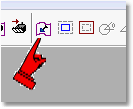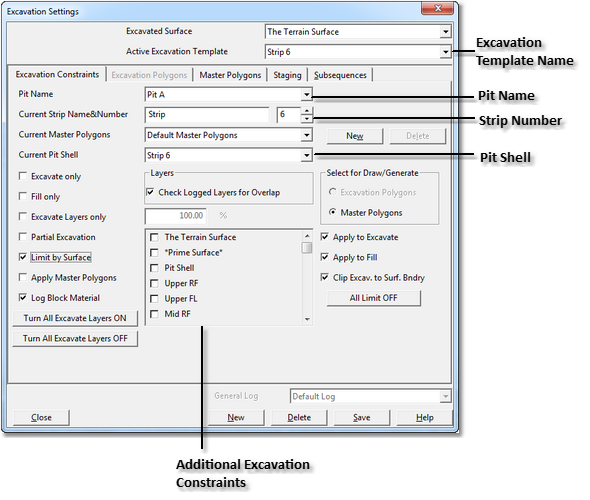|
<< Click to Display Table of Contents >> Creating a Staged Excavation |
  
|
|
<< Click to Display Table of Contents >> Creating a Staged Excavation |
  
|
The concepts and general procedure for creating a staged excavation are described here and in following topics via an example pit.
The following diagram shows the cross-section through the pit:
This pit is operated with advanced stripping, the upper seam and mid seam are excavated one strip in advance of the main seam.This example covers strips 6 and 7.
The strip 6 section has two Passes:
•Lower Seam waste
•Lower Seam Coal
The Strip 7 section has four Passes:
•Upper Seam
•Upper Seam Coal
•Mid Seam Waste
•Mid Seam Coal
Two Excavation Templates are required, one for Strip 6 and One for Strip 7. The Templates are used to produce the Raw Sequences and Subsequences for the Two Strips. The Subsequences are then assembled into a Supersequences using a Supersequence Editor which accesses the Subsequences of all Excavation Templates.
Excavation templates are set up using the Excavation Settings dialog.
A Staged Excavation is created via an Excavation Template. Excavation templates are set up using the Excavation Settings dialog. This dialog is accessed via the Excavation Settings Toolbar button:

Excavation Settings Toolbar Button.
The figure below shows the first page of the Excavation Settings dialog, the excavation constraints page:

The excavation constraints fields most relevant to staged excavations are as follows:
•Active Excavation Template. This is the excavation for the strip to be modelled. It is important when creating the Excavation Template that the name given to the Template indicates the Pit to which it belongs.
•Pit Name. The previous section described the process of establishing Pits and Block lines. All Pits so established will appear in the Pit Name pulldown list. Before creating an excavation template for a Strip in a particular Pit, the pit must be set up in this manner, if so the Pit will appear in this pulldown list.
•Strip Number. The user sets the strip number using the number selector. This is a manual process and the number selected here will be used for the naming of Subsequences. It is important to set this field to the correct strip number.
•Pit Shell. Staged excavations most typically apply to a Strip in a Pit. The Pit Shell surface acts as a constraint and ensures that the staged excavation conforms to the design. Pit Shell surfaces are typically generated by the main mine planning system and imported into 3d-DigPlus. However 3d-DigPlus does have a set of functions which allow the user to create pit shells if necessary.
•Limit by Surface constraints. In some cases the Pit Shell surface alone will not provide sufficient constraint to ensure that the staged excavation produces the desired final surface. In such cases additional constraining surfaces can be selected from this list. When an inner surface is nominated as a limit surface no part of the excavation will extend beyond this surface. Multiple surfaces can be selected.